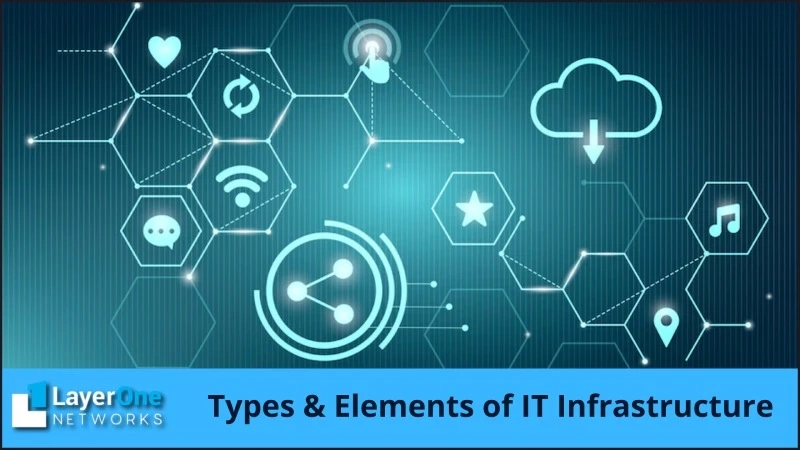Modern businesses rely on information technology (IT) infrastructure for operations, communications, and decision-making. The goal of IT infrastructure is to deliver the right information to the right people at the right time. When technologies and processes are integrated correctly, its IT infrastructure can improve operations and enhance competitive positioning.
You can meet business goals by understanding the key components of IT infrastructure and how they work together. IT consulting firms can also help you assess your business needs and select the right technologies and processes for your organization.
What Are the IT Infrastructure Components?
IT infrastructure components stand for the network, hardware, software, data center, and communications systems that enable your organization to store and manage data. There are many ways to deploy, organize, and manage these components.
Hardware
It includes physical components of a computer system, such as servers, storage devices, and network equipment. Hardware components include keyboards and mouse, output devices like displays and printers, networking hardware such as routers and switches, and storage devices like hard drives, memory cards, and optical disks. Hardware components are also known as "computer hardware."
Software
The programs and applications that you run on your computer or mobile device. The software includes both operating systems, which control the basic functions of a computer or mobile device, and applications like browsers and office productivity software. Software applications integrate web servers, enterprise resource planning, customer relationship management, and database systems.
Network
Networking enables different devices to communicate with each other and share data. Networks are made up of various components, including routers, switches, firewalls, and wireless access points. Networks are wired or wireless, and they can be local area networks (LANs), metropolitan area networks (MANs), or wide area networks (WANs).
Types of Infrastructure - Traditional vs. Cloud
There are two main types of IT infrastructure: traditional and cloud. Traditional infrastructure is self-contained and physically housed in an on-premises data center. Cloud infrastructure is delivered as a service and managed by a cloud provider.
Traditional IT Infrastructure
The traditional model of IT infrastructure consists of on-premises data centers that are owned and operated by the organization. All hardware, software, and networking components are housed in the data center, which is maintained and managed by internal IT staff.
This infrastructure needs significant space and investment in hardware and software and in-house expertise to keep it running smoothly. Also, meeting the demands of an evolving market requires continuous upgrading, maintenance, and supervision. It means you need to pay to team troubleshoot issues, add new features and capabilities, and keep the data center running around the clock.
When to Choose Traditional Infrastructure?
When you want complete control over your data and IT environmentWhen you have the in-house expertise to manage your data centerWhen you want to keep your data and applications on-premisesWhen you have specific compliance requirements that can only be met by hosting data on-premisesCloud IT Infrastructure
The versatility of cloud infrastructure allows you to quickly provision and scale resources as needed without having a huge upfront investment in hardware and software.
Cloud infrastructure is delivered as a service by a cloud provider, who manages cloud services and maintains the underlying hardware and software. You pay for your resources, and you can scale up or down as needed. Migrate your applications and data to the cloud, or build new applications in the cloud.
When to Choose Cloud Infrastructure?
When you want to pay for only the resources you useWhen you need to quickly provision and scale resourcesWhen you want to focus on your core business rather than managing IT infrastructureWhen you need access to specialized tools and expertise that are not available in-houseThere are several benefits to using cloud computing as it is already widespread, and it is quickly becoming the favored choice for businesses of all sizes. However, traditional infrastructure may be a better fit for some organizations.
IT Infrastructure Management
IT organizations need to proactively manage their IT infrastructure's performance, availability, and security. To effectively manage IT infrastructure, you need to have visibility into all aspects of your environment, from the data center to the cloud. There are three main practices: operational management, service management, and asset management.
IT Operational Management (ITOM)
IT operational management refers to the day-to-day management of IT systems and services. The collection of tools and processes used to manage IT operations is often referred to as an Operations Management System (OMS). The goal of ITOM is to keep systems and services running smoothly and efficiently. Data collections, cloud management, and performance monitoring are all part of ITOM.
IT Service Management (ITSM)
IT service management focuses on managing services that are delivered to customers. All activities related to the design, development, deployment, and control of managed IT services fall under ITSM. The goal of ITSM is to ensure that services are delivered in a consistent and reliable manner. Service level agreements (SLAs) are often used to measure and manage service quality. Every customer interaction (whether a request for help or an IT problem that needs to be resolved) is tracked in an ITSM system.
IT Asset Management (ITAM)
IT asset management refers to the tracking and managing of all hardware and software assets throughout their lifecycle. The goal of ITAM is to ensure that assets are properly utilized and accounted for and that they meet all legal and compliance requirements.
Financial: The goal of ITAM is to optimize expenses and minimize risk. It can help organizations ensure that they are getting the most value out of their technology investments and are cost-effective.
Inventory: It means gathering and tracking data related to hardware and software assets, including details such as purchase date, vendor, cost, warranty coverage, etc. This information is controlled by ITAM processes and is used to make decisions about when to upgrade, retire, or replace assets.
Contractual: It ensures that all contractual obligations related to assets are met. It includes renewing licenses and supporting contracts on time, tracking asset utilization, and ensuring that assets are compliant with software licensing terms.
Summing Up
IT infrastructures are now the lifeblood of business. Understanding what they are and how they work is critical to success in the modern world. Multiple technologies make up an organization's IT infrastructure. Digitizing in today's business world means clearly understanding how each element works and how it all fits together.
IT consulting services help you get a clear understanding of your business needs along with the current IT landscape. To stay advanced in the market, you need to future-proof your IT infrastructure. This can be done by investing in the latest technologies, migrating to the cloud, or both.



